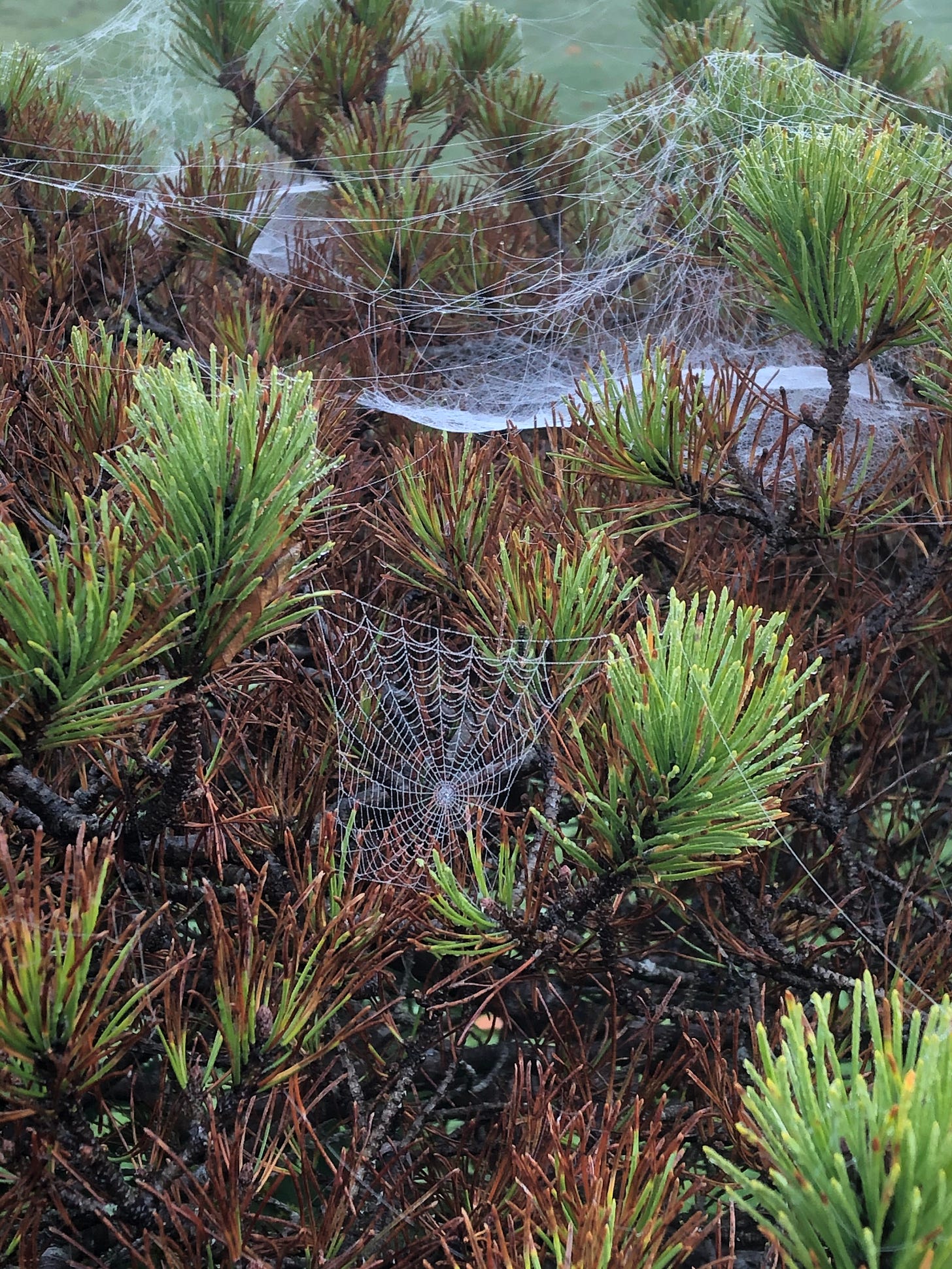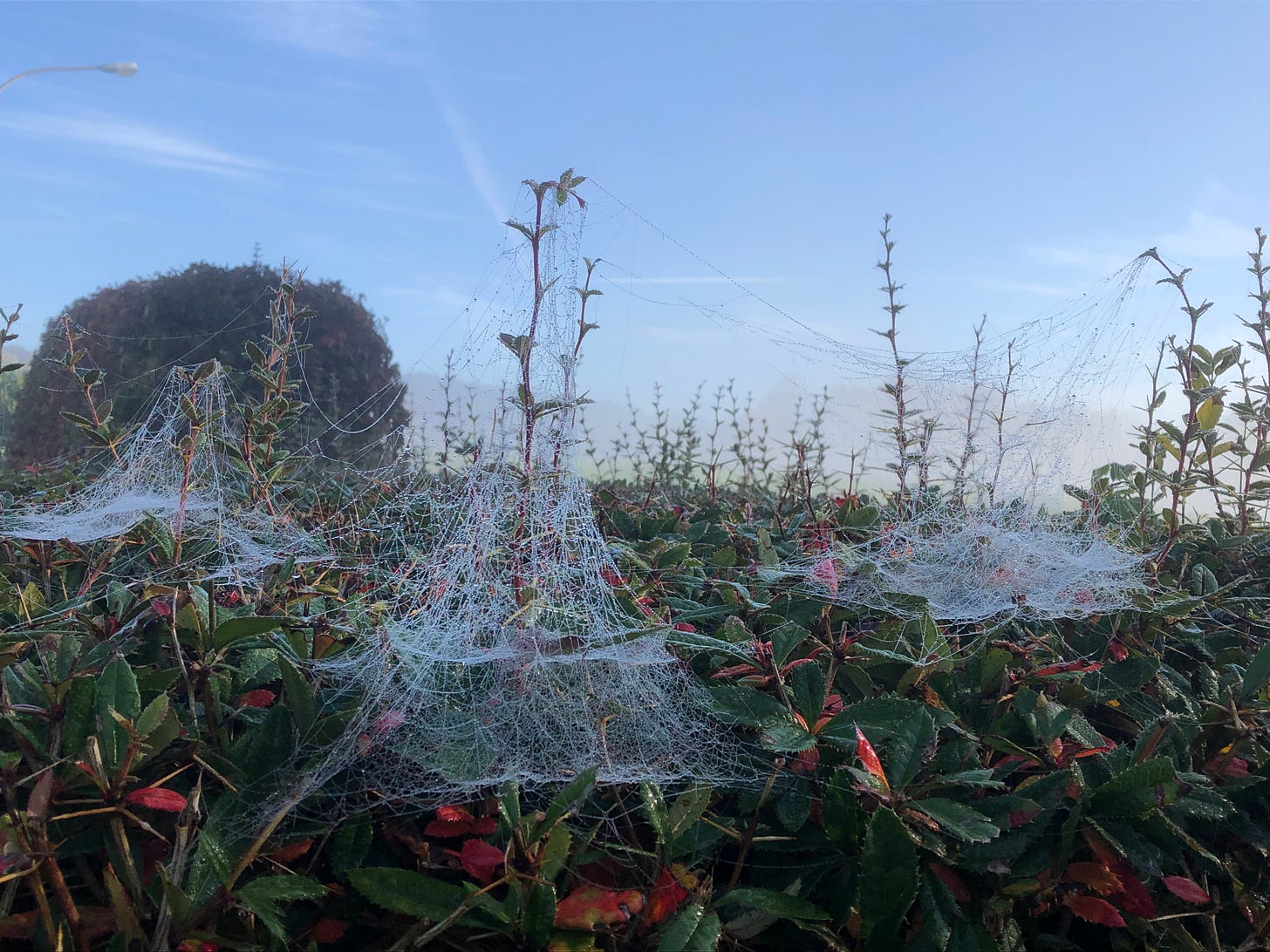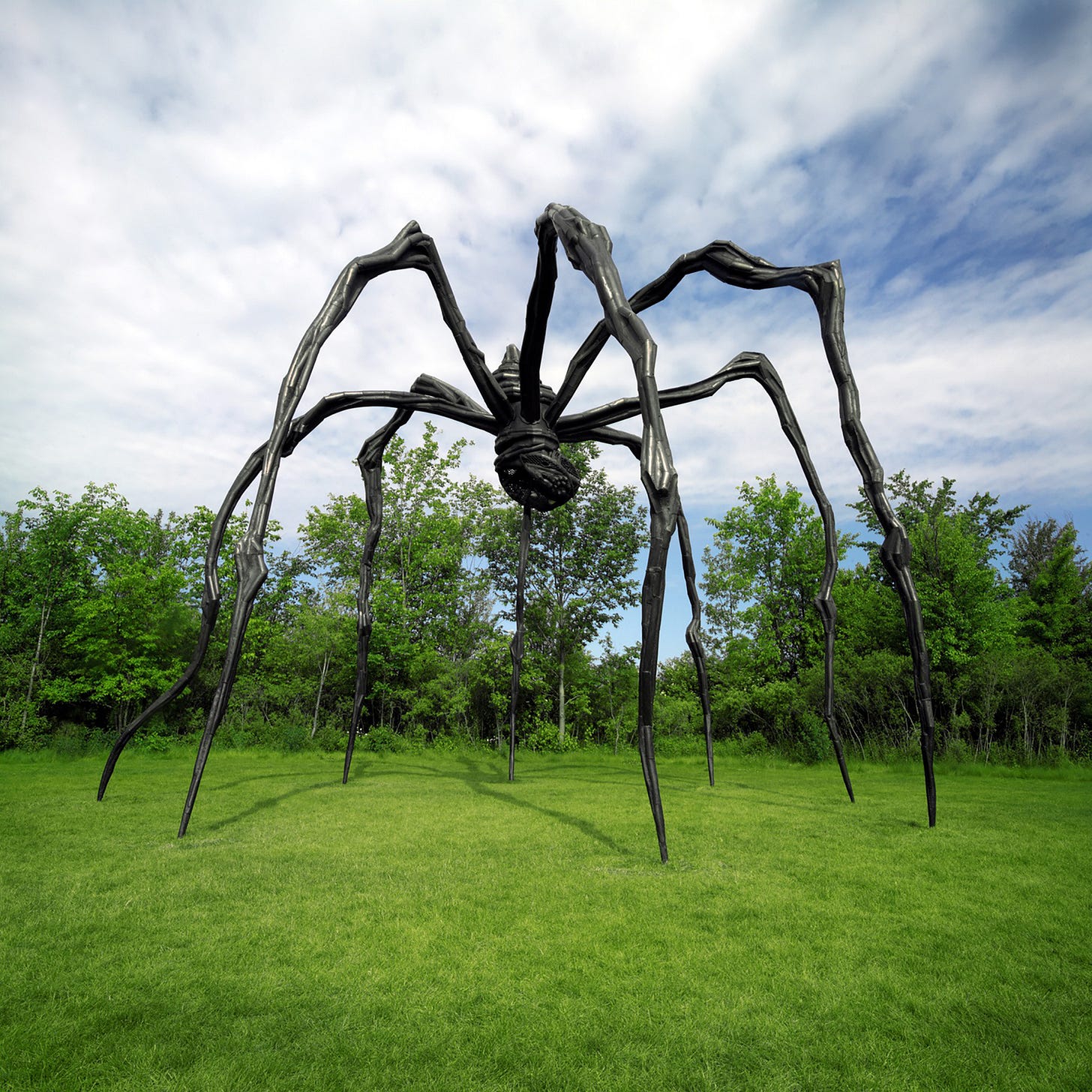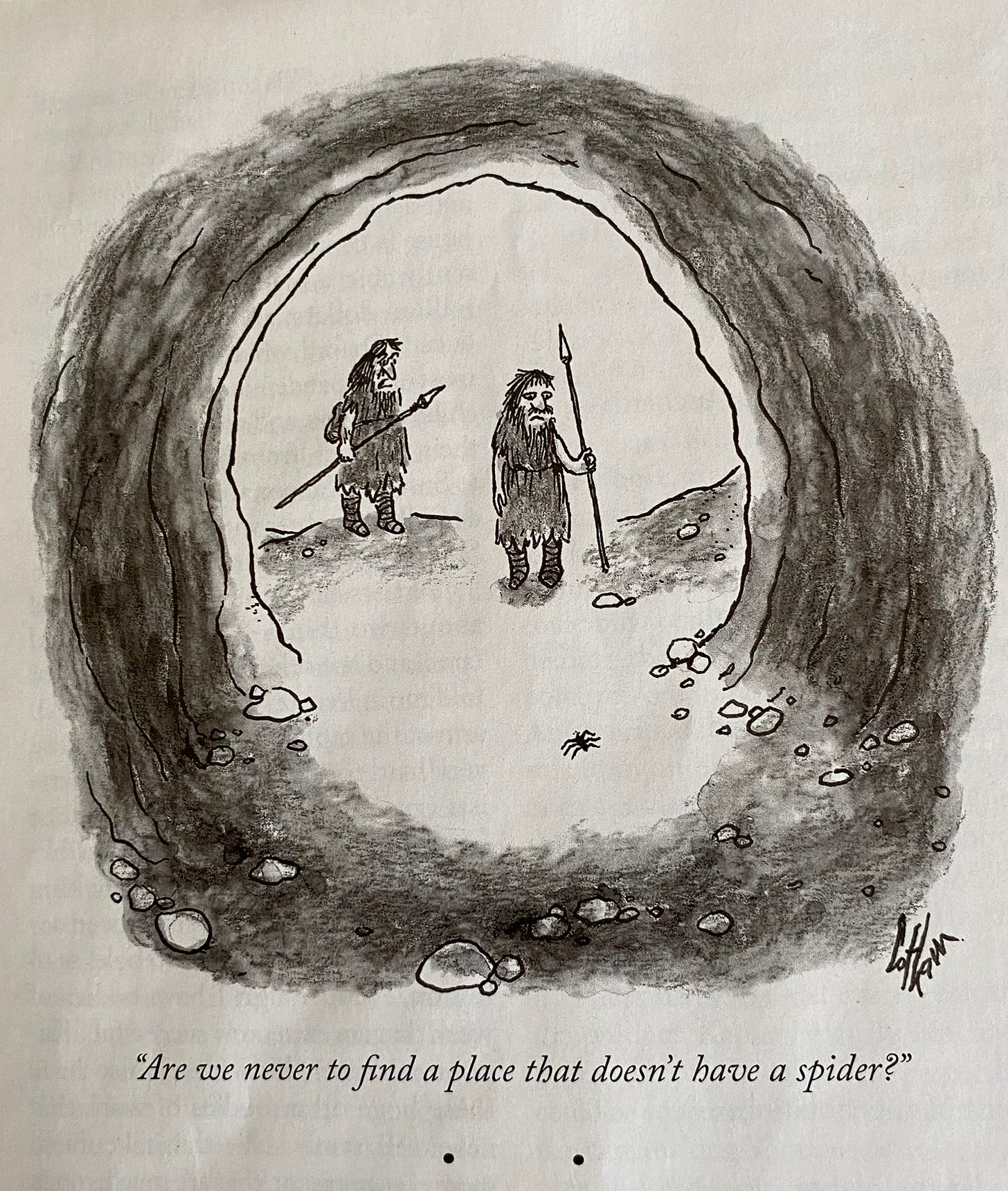As a knitter, I confess to a great fondness for Mother Nature’s textile artists. I marvel at the elegant precision of this tiny web, which a spider left outside our door last fall:
Others of us, perhaps, relate more to the work of this spider, who is a slattern compared with her sister,1 but who exhibits a certain careless flair in the way she strews her silk willy-nilly:
When we lived in Prague, our living room had glass doors to the back yard, and one summer an orb-weaver spider about the size of a ping pong ball covered the whole door with her web and proceeded to devour every bug in sight. (And yes, we stopped using that door while she was in residence.) I dubbed her Lenka, a Czech name that means “light” but also puns on “link,” to suggest the links in the chain of her web, and indeed between all living creatures.

I have always loved to watch spiders as they weave their webs—their intricate, delicate activity, their sudden leaps, their apparent levitation. In our house, no one kills spiders, ever. Should one of the arachnophobic members of the family (who shall remain nameless) spot a spider, they call me to trap and release her outside—after I first channel Marie Kondo and thank her for her service in ridding our home of pests.
Fun Spider Facts
Most readers likely already know a number of facts about spiders—that their silk is five times stronger than steel, that their webs have both sticky fibers to trap prey and nonsticky fibers on which the spider walks (and that the spider knows the difference), that they are capable of learning how to weave their webs in zero gravity, that some spiders eat their webs to recycle the amino acids in the fibers, that tarantulas defend themselves by shooting their hair at predators, that some spiders prey on fish and birds. I also learned from this article that some male spiders actually want to be eaten, and if the female spits them out they will thrust themselves back into her jaws. (I know this sounds like a metaphor for online dating, but I assure you that it is a real fact.)
I recently read Ed Yong’s fascinating and entertaining book An Immense World: How Animal Senses Reveal the Hidden Realms around Us (highly recommended!), which is full of information about spiders that was hitherto unknown to me, and maybe also to you. The fun facts and quotes below come from Yong’s book and are only a tiny fraction of what I learned about spiders from him.
Anyone who has read Charlotte’s Web knows that spiders travel by “ballooning”—by sending out strands of silk that carry them aloft. You might think that the spiders are lifted by the wind, but in fact the propulsive force is electricity: “Spider silk picks up a negative charge as it leaves a spider’s body, and is repelled by the negatively charged plants on which they sit.”
Nephila spiders (a kind of orb-weaver) create webs so large and strong that they can trap bats. The web is not only a trap but “also a surveillance system, which extends the range of the spider’s senses well beyond the reach of its body.” When anything touches a part of the web, vibrations travel along the fibers to the spiders, and the spiders perceive the vibrations through tiny cracks in their bodies. Spiders can distinguish between vibrations caused by wind, leaves, or branches on the one hand, and those caused by their prey on the other, and they can even figure out their prey’s size and location from the vibrations.
Unfortunately for the Nephila, the Portia jumping spider (named for Shakespeare’s clever but ruthless heroine?), when on the hunt, will exploit the Nephilas’ ability to tell what has hit the web in order to trick them. The Portia will “violently twang a web to mimic the impact of a twig and use this vibrational smoke screen to charge at” and eat up the Nephila spider snip snap.
Jumping spiders have “close to wraparound vision” and can visually track a researcher’s finger as she moves it around them. Unlike most other spider species, who prefer to chill in their webs and wait for their dinner to come to them, jumping spiders—as the name implies—are much more active. Those nefarious Portia jumping spiders, for example, plan out “strategic routes when stalking prey” and can switch tactics midstream. This is possible in part because jumping spiders’ four pairs of eyes each perform different tasks: “The central ones recognize patterns and shapes and see in color. The secondary ones track movements and redirect attention.” Another pair sees motion behind the spider, and the fourth pair’s function is as yet unclear.
Have I convinced you that spiders are fascinating creatures with their own strange beauty? Not yet? Oh well. Let’s turn to the arts then.
Spiders in the Arts
Emily Dickinson, a keen observer of the natural world, has written three poems about spiders. Below is my favorite, but you can find the others here and here. Dickinson honors the spider’s speed and skill at weaving, which far surpasses ours, and laments that her creations are transitory and unappreciated:
The spider holds a Silver Ball
In unperceived Hands—
And dancing softly to Himself
His Yarn of Pearl—unwinds—
He plies from Nought to Nought—
In unsubstantial Trade—
Supplants our Tapestries with His—
In half the period—
An Hour to rear supreme
His Continents of Light—
Then dangle from the Housewife’s Broom—
His Boundaries—forgot—
Walt Whitman celebrates the spider’s bold leaps, which for him symbolize our efforts to bridge the oceans that divide us. We need only extend a “gossamer thread” to connect:
A noiseless patient spider,
I mark’d where on a little promontory it stood isolated,
Mark’d how to explore the vacant vast surrounding,
It launch’d forth filament, filament, filament, out of itself,
Ever unreeling them, ever tirelessly speeding them.
And you O my soul where you stand,
Surrounded, detached, in measureless oceans of space,
Ceaselessly musing, venturing, throwing, seeking the spheres to connect them,
Till the bridge you will need be form’d, till the ductile anchor hold,
Till the gossamer thread you fling catch somewhere, O my soul.
Probably the most famous depictions of spiders in art are Louise Bourgeois’s monumental sculptures of them. Her sculptures may look creepy to us adults, but when they are accessible to the public in sculpture gardens, children like to run around and play among their legs. This article describes the paradoxical reaction viewers might have to Bourgeois’s spiders, which “are ambivalent creatures. The spider is an image of creativity and industry . . . and also one of fear and disgust.”
Disgust and Curiosity
“Fear and disgust” brings me to my point—beyond sharing my enthusiasm for my arachnoid friends, that is. It’s almost Halloween, the only time when spiders enjoy the popularity they deserve. Shops and homes are festooned with decorative webs, and adorable plush spiders lurk fetchingly in the corners. And yet I find myself wishing that more people appreciated spiders not only as cute decorations, but for what they really are—for their hairy bodies and bulbous bellies; for their fecundity; for their unnerving tendency to materialize, suspended on a filament, before our eyes; for their extravagance in the leg department, to the tune of six;2 for their uncanny predilection for skittering about; for their way of lying in wait to drain their prey. Readers are likely familiar with the saying “You’re never more than three feet from a spider.”3 They live among us. Why not try accepting or even welcoming them?
Why not indeed? Well, one obstacle to acceptance—of spiders or of anything else that freaks us out—is the primal emotion of disgust. Disgust is considered to be one of six universal emotions (the others are happiness, sadness, anger, surprise, and fear). In our evolutionary past, disgust protected us from poisons, infections, attacks, and other dangers. However, the emotion can be maladaptive now if it separates us from the natural world and other people, or causes us to feel distress in situations that don’t warrant it. Most of us don’t need to worry about poisonous spiders, after all.
The good news is that we are capable of resisting these feelings of disgust and of striving for understanding and connection instead.4 We can’t control our feelings, but we can control what we do with them. Whenever I feel disgust, I try to convert that feeling into curiosity. Why did I react this way? What does that say about me and what I value—or fear? Why might the other living being or culture have this practice? Might they have a good reason? Readers can probably think of myriad examples of people who were formerly viewed as disgusting but who now are understood to be just as human as everyone else, because people decided to resist their disgust and to get curious instead.
Here’s a recent example of how I responded to my disgusted feelings with curiosity and learned something in the process: When we were in Florence last week, we took a private walking tour, and our guide told us about traditional Florentine dishes. While most of them sounded delicious (gelato! ribollita! pasta with mushrooms!), one, lampredotto, or beef tripe, filled me with disgust. Blech! I thought. So slimy and stinky! Tripe just isn’t something we Americans—especially those of us who are vegetarians—want to eat. But then I got curious, thought about it, and realized that tripe is simply a morally neutral cultural difference; Americans eat the meat from the outside, rather than the inside, of the cow, and that’s all. In fact, in times and places where money is tight, it makes sense not to waste potential sources of protein. Lampredotto is “an example of cucina povera, or modest peasant fare, made up of ‘salvaged’ ingredients.” The Florentine practice of cooking all parts of the animal is good for people’s health and the environment alike.
You may never feel the affection for spiders that I do, and I guarantee that I will never eat tripe, but we all are capable of refusing to succumb to feelings of disgust when we encounter something different or new, and of trying to learn and understand instead.
How about you, readers? Is there something that grosses most people out, but that you have always enjoyed or have taught yourself to appreciate? Please share your thoughts in the comments!
The Tidbit
I thought it would be fun to include a spider-themed recipe for the tidbit, and then I made the mistake of Googling “spider recipe.” Most of the results were barely even recipes—for example, one “recipe” just tells us to stick pretzels into marshmallows, and another instructs us to pour melted chocolate over chow mein noodles. But then there were also recipes featuring actual spiders, including one for deep-fried tarantulas. I thought it was a joke at first, but it turns out to be real.5 No thank you! I like tarantulas, but not to eat!
So I turned to music for inspiration. While as far as I know Bach never composed anything with spiders in mind, this gigue, the final movement of his first partita, captures the spirit of a spider weaving her web, at least to me. Listen for how Glenn Gould’s interpretation brings out the order—the melody—from the seeming chaos of the surrounding notes whirling around, in the same way as the geometrical, symmetrical web emerges from the spider’s furious activity. The movement is only a minute and twenty seconds long and is absolutely delightful; do give it a listen!
Obviously I know that spiders come in male and female flavors; if it weren’t for male spiders, what would black widows eat? But in my opinion, spiders, like ships, are gendered female. That’s my story, and I’m sticking to it.
This is an allusion to one of my all-time favorite comedy sketches, from Beyond the Fringe, in which a one-legged Dudley Moore auditions for the role of Tarzan and is told by Peter Cook that he is “short in the leg department, to the tune of one.”
I like to joke that the Swiss version of this saying is “You’re never more than three blocks from a cow.”
For a lighter take on this topic, I recommend Give Up, Get a Tarantula, by Eileen Curtright. Curtright is not only funny but also a very good mom.
Amusingly, the recipe has earned a rating of three out of five stars. One reviewer assures us that the tarantulas taste like chicken.






Thank you, Mari. I enjoyed your piece.
When I worked in the prison, some inmates told me they had “pet” spiders in their cells that they fed and talked to. Who could blame them?
Claudy Edwards (Jan)
Over the years I have read short articles about spiders. I usually stop in disgust but KNOW I should appreciate them. This article was perfect. The appreciation overcomes the reluctance. I sent this to a few social media sites because who doesn't want to wake up near Halloween and read about Portia?
The Joro spider has invaded Georgia and is on the move throughout the US. Spiders are the constant topic where I live.
https://news.uga.edu/joro-spiders-likely-to-spread-beyond-georgia/